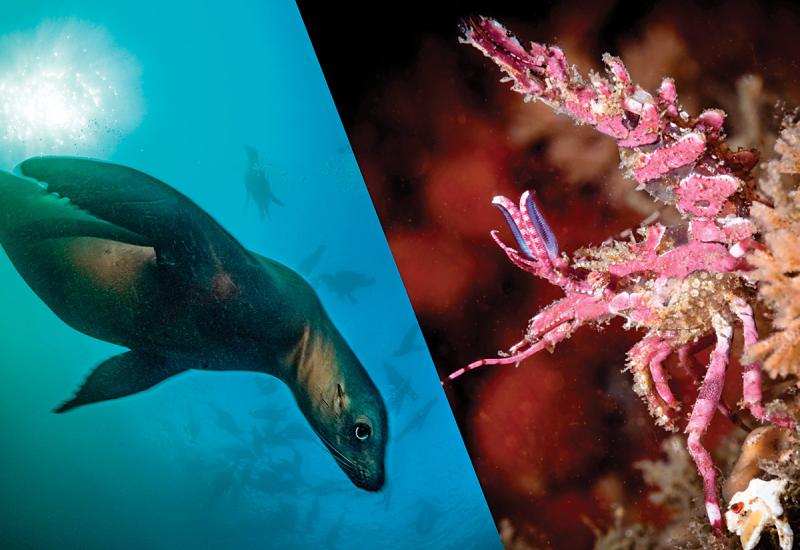H2Organisms: Exploring the Intricate World Below the Surface

Patrick WebsterA swarm of nematocyst-clad sea nettles, and one moon jelly, fill the space between sand and surface in Monterey Bay, California.
It’s difficult to describe the magic of seeing beneath the water’s surface, but underwater photography has shown me its universal effect on people. You could spend your whole life right next to the water— looking at it, letting it lap at your feet or buoy your boat—and still, that thin veil of liquid that separates sea and lake from sky is a deceptive, secretive shroud.
It is another world out there, and not just figuratively! Above the water, the strictures of atmospheric life—especially gravity—force earthly organisms to occupy a thin crust of existence that, from a distance, might as well be twodimensional. Certainly, birds, bats, and bugs have given skyborne life a valiant effort; pollen, spores and viruses could also be considered “atmospheric plankton” if we’re feeling generous.
Related Reading: Everything (And More) You've Wanted to Know About the Siphonophore
But in the ocean, life can and does exist from the surface to the seafloor—a seafloor on average 2.3 miles, or 370 atmospheres of pressure, away. Larval and adult organisms alike drift or commute on the currents, many diving and rising weightlessly thousands of feet through an aquatic medium 800 times denser than the air above. And ocean life came first, with opportunities to diversify into fresh water along the way, so while we know of more species on land, we and our air-born counterparts are all ultimately some derivative of an aquatic innovation, from plants to people.
In fact, of the 30-some animal phyla that we recognize currently, all of them exist in the marine environment, and a dozen or so exist exclusively in the ocean, having never ventured ashore. These oceanic beings are as dissimilar from each other as we are from spiders, and we have no counterpart for them on land. And funnily enough, the most recognizable ocean animals for us divers mostly aren’t in those ocean-only phyla. Octopuses? They’re just glorified escargot cousins. Fishes? That’s us! Humans are relatives of the lobe-finned sarcopterygians and coelacanths. Crabs and shrimp and lobsters—sea bugs, all! Whales, dolphins, seals, sea lions, sea turtles—all animals with a bad case of evolutionary take-backsies that tried the land thing, thought better of it, and returned to the sea.
Related Reading: Jellyfish and the Art of Mindful Underwater Photography
No, it’s the echinoderms, the starfishes, urchins and cucumbers, the sponges and the tunicates, that offer themselves as emissaries to what life can be without needing to innovate beyond a salty homestead. And we could consider them as aquatic as they come, if it weren’t for those that looked at the very medium of life itself, the water surrounding them, and figured, “Hey, what if I was made of that?”
Whether it’s the marine-exclusive comb jellies, or the aquatic stalwarts cnidarian jellyfishes, these loosely organized water beings—H2Organisms, if you will—make me dream of what extraterrestrial life may actually look like, should we eventually find it beneath the surface of another water world. I used to dread the arrival of a jelly bloom, the memory of swollen lips and burning skin enough to push the dive day off until they’d dissipated. Now I relish the opportunity to commune with the bounty of booger beings, to spend time hovering in Inner Space in the presence of the closest thing to an alien that I will ever have access to. Because jellies are the life-water of our planet becoming living water, the very essence of existence made corporeal and delightfully jiggly.
What if our planet or those far-off worlds eventually made it to a point where our atmospheres come alive in a similar way to our ocean—with airy animals made of weaponized wind devouring each other and digesting themselves into the clouds? Such a world would be the subject of a summer blockbuster, inspiring millions to think beyond the world we’ve grown most accustomed to. And yet that exact world exists right here, on our planet, in our collective backyards, hidden just beneath the surface. I can’t wait for the next opportunity to dive into a stinging ocean, to remind myself of the truest spice of life that we have at our glovetips.

e8d8.jpg)








